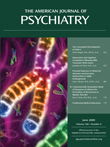PTSD Diagnostic Criteria: Understanding Etiology and Treatment
To the Editor: In their article, published in the January 2009 issue of the Journal , Carol S. North, M.D., M.P.E., et al. (1) offered recommendations concerning refinement and validation of the diagnosis of posttraumatic stress disorder (PTSD). The authors concluded that “avoidance and numbing symptoms represent the core of psychopathology as currently written in the DSM-IV-TR” ( 1 , p. 39). These conclusions have important implications for DSM-V. However, there are other considerations about avoidance and numbing relevant to the criteria set for PTSD that the authors did not discuss. First, there is a growing body of factor analytic research showing that effortful avoidance (i.e., deliberate attempts to avoid trauma reminders) and numbing are distinct groups of PTSD symptoms (2) . If factors identified by factor analysis correspond to distinct groups of causal mechanisms (3) , then research into the etiology of PTSD would be hindered by blurring the distinction between effortful avoidance and numbing. Second, DSM-IV-TR criteria for PTSD include five numbing symptoms but only two effortful avoidance symptoms. In order to reliably assess various manifestations of effortful avoidance, more of these symptoms need to be included in DSM-V. Third, based on DSM-IV-TR criteria, PTSD can be diagnosed even in the absence of effortful avoidance. If effortful avoidance is one of the core features of PTSD, then such symptoms should be required to diagnose PTSD. Fourth, the existence of trauma-related, psychogenic amnesia is controversial (4) , thereby undermining validity of the PTSD diagnosis. Even if such amnesia is a clinical reality, it is different than effortful avoidance of trauma memories and, more likely than not, distinct from numbing. This latter point is underscored by reanalysis of data from 60 PTSD patients in one of our recent studies (5) in which a 5-item numbing scale was created from scores on the Clinician-Administered PTSD Scale. Amnesia had a corrected item-total correlation that was no different from zero (r=–0.08) compared with a range of 0.16–0.54 for the other numbing items. In short, amnesia was unrelated to other numbing items. It seems prudent to omit this symptom from DSM-V. Finally, if avoidance and numbing are the core features, is PTSD simply a combination of specific phobia and depression (6) ? An important step in validating PTSD is to demonstrate that it has incremental validity over specific phobia and depression—that is, to show that the diagnosis of PTSD conveys important information relevant to understanding the etiology and treatment of trauma-related psychopathology that is not conveyed by a combination of these other diagnoses.
1. North CS, Suris AM, Davis M, Smith RP: Toward validation of the diagnosis of posttraumatic stress disorder. Am J Psychiatry 2009; 166:34–41Google Scholar
2. Asmundson GJ, Stapleton JA, Taylor S: Are avoidance and numbing distinct PTSD symptom clusters? J Trauma Stress 2004; 7:467–475Google Scholar
3. Cattell RB: The Scientific Use of Factor Analysis in the Behavioral and Life Sciences. New York, Plenum, 1978Google Scholar
4. McNally RJ: Remembering Trauma. Cambridge, Mass, Harvard University Press, 2003Google Scholar
5. Taylor S, Thordarson DS, Maxfield L, Fedoroff IC, Lovell K, Ogrodniczuk J: Comparative efficacy, speed, and adverse effects of three treatments for PTSD: exposure therapy, EMDR, and relaxation training. J Consult Clin Psychol 2003; 71:330–338Google Scholar
6. Rosen GM, Spitzer RL, McHugh PR: Problems with the post-traumatic stress disorder diagnosis and its future in DSM-V. Br J Psychiatry 2008; 192:3–4Google Scholar



